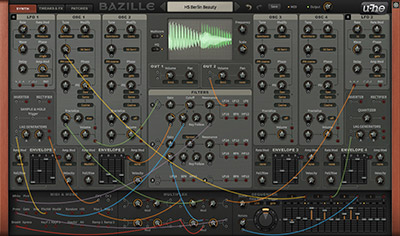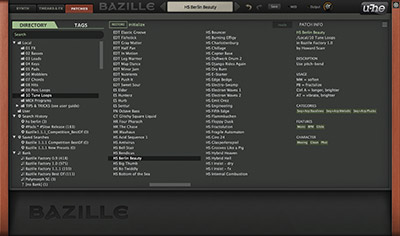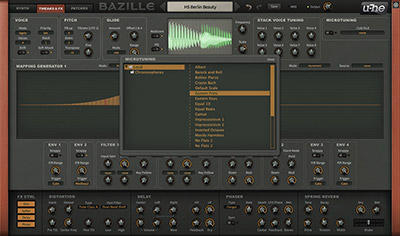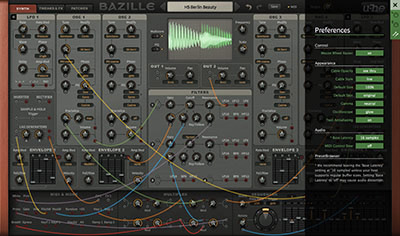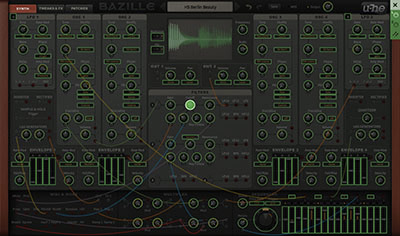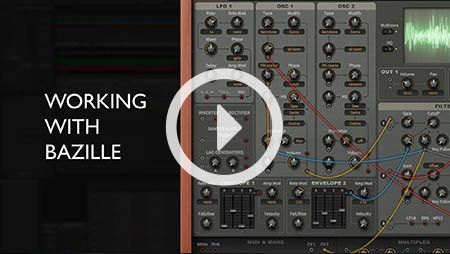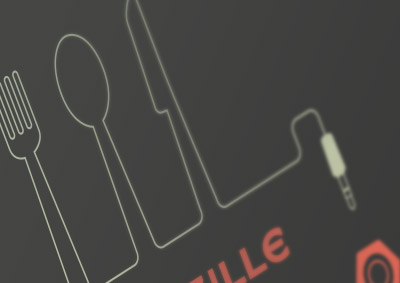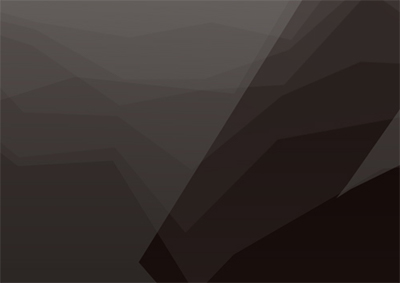

Modular Synthesizer
Bazille: Monster from the deep
The second spawn of the Berlin Modular project, Bazille is a large polyphonic modular system with digital (PD, FM based) oscillators, multimode filters and plenty of modulation options. With so much connectivity to explore, patching in Bazille should keep you fascinated for many years – it’s definitely a “geek machine”!
Bazille in the spotlight…
Hover over the dots  to learn about Bazille’s features
to learn about Bazille’s features
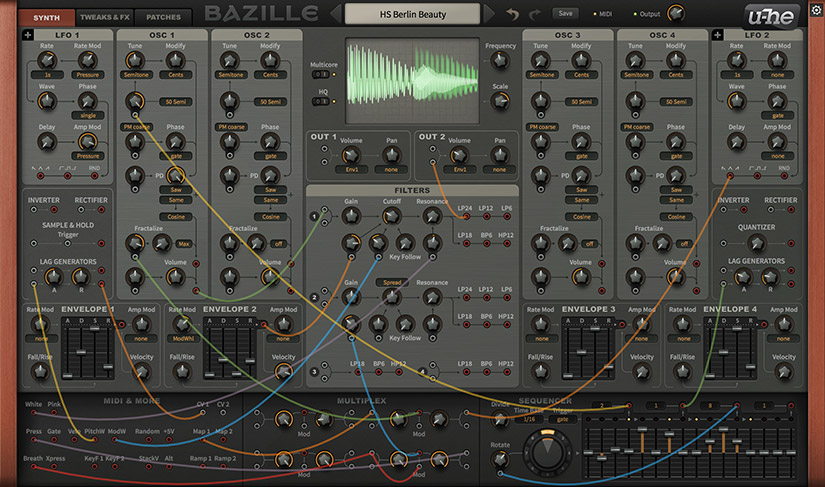
- modular, stereo, up to 16-voice polyphonic
- 4 digital oscillators based on phase distortion (PD) with FM and fractal resonance (FR)
- 4 self-oscillating multimode filters with up to 6 parallel outputs each
- 4 ADSR envelopes with Fall/Rise for the sustain stage, overall rate can be modulated
- 2 LFOs with 3 parallel outputs each, unipolar option
- 16-step morphing sequence per voice, with 8 snapshots and 4 output taps
- 2 mapping generators with up to 128 steps, comprehensive drawing tools, presets…
- maps can be used as oscillator waveforms
- 4 Multiplex modules for mixing signals, cross-fading, ring modulation, amplitude modulation etc.
- 4 effects: stereo delay, distortion (6 types), phaser (2 types), spring reverb
- 2x inverter, 2x rectifier, sample & hold, 2x twin lag generators, quantizer
- over 1700 factory presets
- NEW in v1.1.2: Support for Oddsound MTS-ESP
- NEW in v1.1.3: MPE Support
Sights and sounds
- Screenshots
- Demo Tracks
- Videos
Cinematic Demo
Big soundtrack style demo by Kevin Schroeder.Modern Dance
Modern dance examples by Eternitysounds.Petri Dish Romance
A piece by Ned BouhalassaBazilleum
Excerpt from a track by Faber. Bazille is a large modular system combining digital oscillators with analogue-style filters and modelled effects, with a flexibility that only modular patching can provide. After ACE, the second spawn of our ongoing Berlin Modular project, this one is a very different, much larger beast …
Those in the know have been waiting for this since 2009.
Berlin Modular
“About four years ago I started to work on a new synthesizer. The idea was to build a virtual modular system much like the first modular system I ever used in 1986—an old and hilariously out of tune Roland System 100M. I totally loved that thing. It stood in a room in my grammar school, and I spent hours and hours patching it up.
“Over the last couple of years I built a little modular synth based on Doepfer’s Eurorack modules. It has become a nice and inspiring hobby, but it’s also quite expensive and for me (as a software user) really difficult to work with. I’m used to being able to save patches, I’m used to having multiple instances of my synth, and I’m used to play chords. All these things are simply non-existant in an analogue modular system. On the other hand you have that tactile thing with the hands-on experience. Plugging cables, turning real knobs and all that is very rewarding compared to just pushing a mouse.
“Nevertheless, I have always kept the idea of a software modular system in the back of my mind. Recently some other ideas somehow nicely aligned with that concept, and the Berlin Modular project experienced a massive boost in pace!
“Of course the name Berlin Modular is meant to be reminiscent of the Berlin School of electronic music, and expecially of the bands and artists I listened to when I was a teenager. Those guys e.g. Tangerine Dream and Jean-Michel Jarre inspired me to make electronic music my hobby, and in the end they also inspired me to develop synthesizers. So what could be more obvious than dedicating a synth to their style?
“The idea is easily explained: Imagine you have a modular system in a rackmount enclosure with a couple of oscillators, a couple of filters and envelopes. Now imagine you have three or four of these systems with different types of modules. That’s the basic concept: Similar systems based on different modules. They are already nicely put together and ready to make some noise!
“A while ago I demonstrated a prototype of the first system within Berlin Modular. I call it Bazille, which is German for bacterium. It has become quite a crazy fellow! Bazille combines 4-oscillator FM-synthesis and Phase Distortion with the depth and flexibility of modular patching …”
Features
Ultraflexible modules
Bazille is highly unusual for a modular synth.
Although the filters are traditional analogue models, the oscillators are unashamedly digital: They combine the two technologies that made digital synthesis affordable (and analogue synths suddenly unfashionable) in the
1980s – FM (frequency modulation, more correctly ‘phase modulation’) and PD (phase distortion).
In Bazille, each oscillator panel has five distinct sections:
Pitch, Phase / FM, Phase Distortion, Fractal Resonance, and the Outputs, each with a modulation input.
Since the 4 main oscillators have a frequency range which starts at zero Hertz, they can be used as synchronized or unsynchronized LFOs or also adopt custom shapes thanks to Bazille’s mapping generators. The oscillators are also capable of all kinds of FM sounds by plugging an audio-frequency source into the phase modulation input.
One of the most interesting features included in Bazille’s powerful oscillators is an unusual process we call Fractalize (fractal resonance). This can be used to create very bold sounds from tame waveforms, with a similar result to the classic cutting sound of the sync effect.
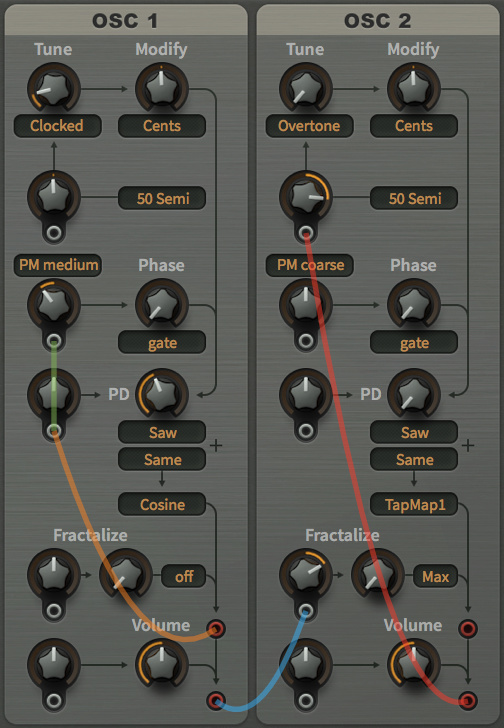
2 of Bazille’s oscillators
Mapping generators
The pair of Mapping Generators can be used for a variety of purposes: To reshape modulation sources, to define per-MIDI-note offsets or to step through values e.g. for round-robin effects … There are 4 modes available, and both generators can have maps with up to 128 steps. They are very flexible, allowing custom shapes thanks to the drawing tools and presets accessible with a right-click of the mouse.

Mapping generators
Multiplex
The little multiple" modules you can find in most analogue modular systems are simple mix/split devices. As Bazille’s output sockets can accommodate several cables, the humble multiple underwent a serious redesign, emerging as something so flexible that we had to rename it Multiplex. The 4 units are very “general-purpose”: They can be used as signal mixers, cross faders, ring modulators, amplitude modulators, and more …
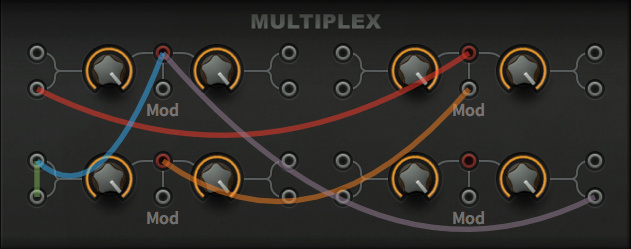
Multiplex section
Modulation sequencer
The onboard modulation sequencer lets you set up much more complex movements than are available with a regular LFO. It can be divided into 2, 3 or 4 sections, two of which can also be used as a per-voice note sequencers (steps can trigger envelopes). Also present is a modulatable Rotate control, which lets you morph between up to 8 different sequences.

Modulation sequencer
Alternative skin
Would you prefer all controls on a single page?
Bazille ships with a larger but more compact skin called GearPorn which dramatically alters the user experience. Ideal for Bazille experts, the skin of choice for ambitious novices.
To enable the skin, just right-click on Bazille’s interface and select it from the menu.
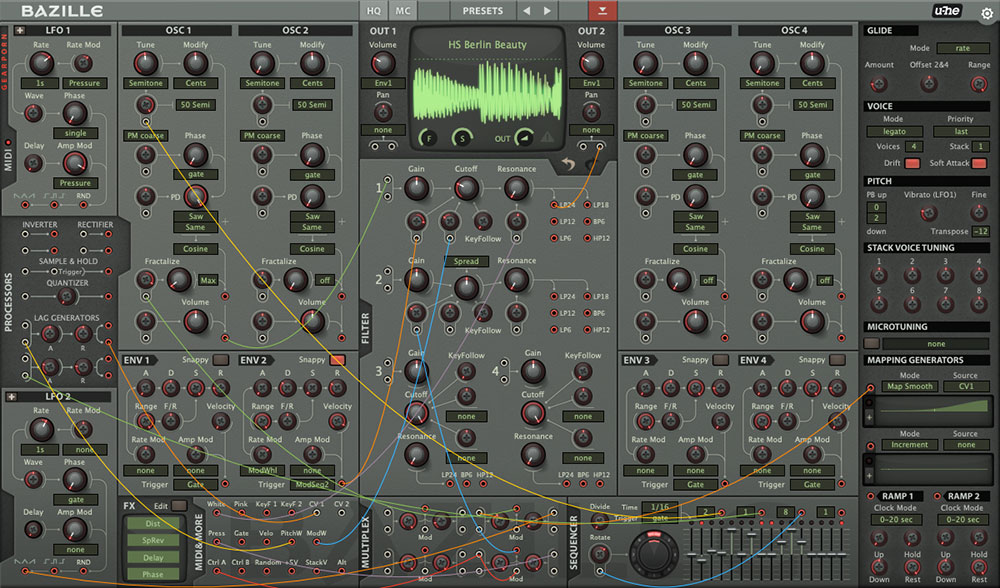
Bazille’s GearPorn skin

December 2010
2010 – Editor’s ChoiceComputer Music
“… a brilliant production tool, and its broad array of features give it extraordinary flexibility and obvious longevity.”
November 2015
“… a very nicely designed machine with a lot of possibilities that you won’t find put together like this anywhere else.”
November 2014
“Anyone dreaming of a new virtual workhorse with extensive modulation capabilities should be happy waking up to Bazille.”
November 2014
“Bazille is a very deep and complex system capable of a lot of diversity in sounds …”
November 2014
“It’s hard to conceive of anything that this synth can’t do.”
March 2015
Oscillators
4 digital oscillators with simultaneous frequency modulation (FM), phase distortion (PD) and fractal resonance (FR) synthesis
Filters
4 self-oscillating analogue-style filters with up to 6 parallel outputs each (lowpass, bandpass, highpass)
Envelopes
4 ADS(S)R envelopes (attack, decay, sustain, sustain2, decay, release) with fall and rise controls
LFOs
2 LFOs with various shapes, 3 parallel outputs each and unipolar switch
Generators
White and pink noise generators
Signal Processors
Inverter, rectifier, sample & hold, lag generators and quantizer
Multiplex
4 Multiplex modules for signal mixing, cross-fading, ring modulation, amplitude modulation and more
Oscilloscope
Configuration
- Resizable UI from 70% to 200%
- MIDI learn page and editable list
- Global preferences page
Tweaks & FX
- 2 mapping generators with up to 128 steps, robust drawing tools and options
- Dedicated glide, pitch and vibrato controls
- Voice stacking, stack tuning, voice drift and soft attack options
- 4 modelled effects: stereo delay, distortion (6 types), phaser (2 types), spring reverb
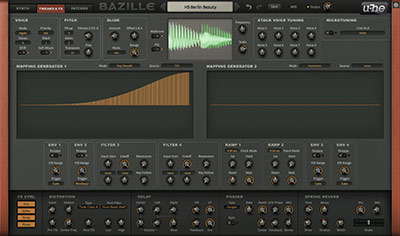

Download the demo and enter your serial number to unlock the full version. The demo version emits crackling sound at irregular intervals.
Bazille 1.1.3 (revision 16518)
Released August 27, 2024
Release notes
* About Linux: Before purchasing, please be aware the Linux versions of our plug-ins are still considered beta. While the plug-ins are stable, we are not able to provide the same level of support for these products as we do for the macOS and Windows versions. Support is provided via the Linux and u-he communities on our forum ![]() .
.
Requirements
![]() Mac OS X 10.10 or newer
Mac OS X 10.10 or newer
or
![]() Windows 7 or newer
Windows 7 or newer
or
![]() Linux
Linux
- Host software / DAW
- 1GB RAM, more recommended
- 1000 × 600 or larger display
- 65-125 MB free disk space
- Modern CPU required:
Windows/Linux: Intel Nehalem or newer, AMD Bulldozer or newer
Mac: Intel Nehalem or newer, Apple silicon M1 or newer - Linux: glibc version 2.28 or newer
Formats
Bazille is not a standalone product, it requires host software. Bazille is compatible with nearly all DAWs.
macOS:
CLAP, AUv2, VST3, AAX*
64-bit
Windows:
VST3
32-/64-bit
CLAP, AAX*
64-bit
* AAX requires Pro Tools 10.3.7 or later
![]()
VST is a trademark of Steinberg Media Technologies GmbH, registered in Europe and other countries.
User Guides

Downloads for Bazille
Try the latest builds of Bazille, which include improvements and bug fixes. Note: these are stable, but still beta versions.
Older Bazille installers are in our release archive (for legacy systems).



